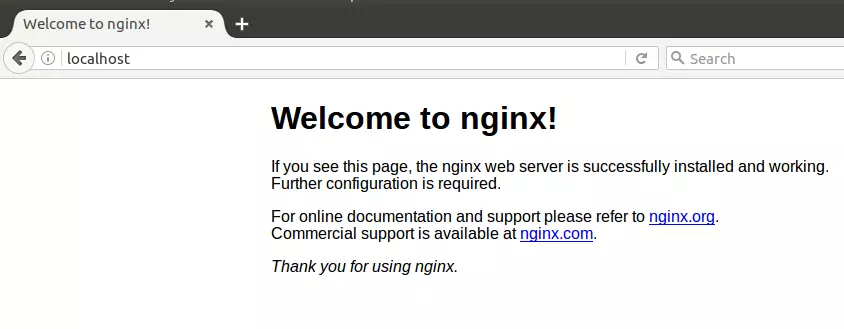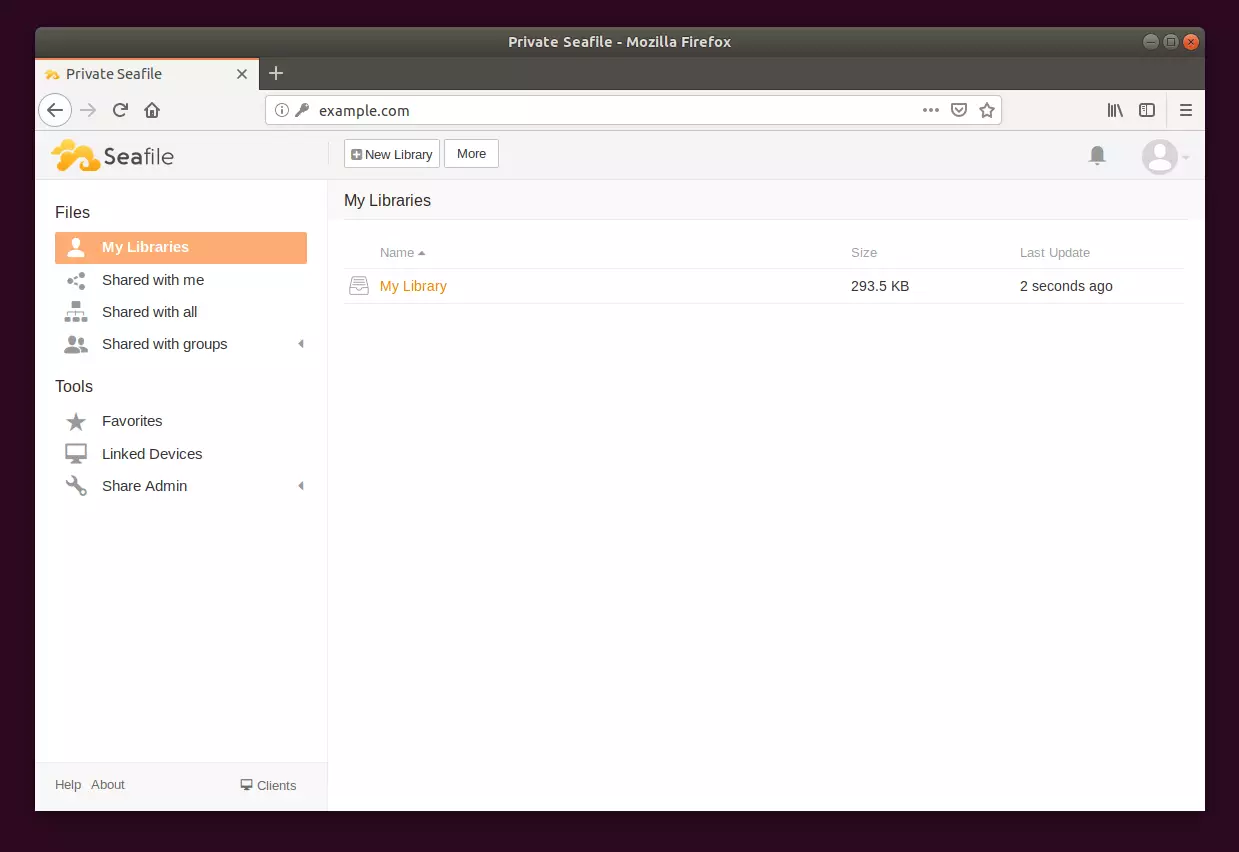This article explains setting up a Seafile server on Ubuntu Linux with Nginx support.
Seafile is a genuinely open-source, self-hosted cloud storage service with high performance and reliability that you host in your environment on your private servers.
Setting up a Seafile server with Nginx support on Ubuntu Linux allows you to have a self-hosted cloud storage service with high performance and reliability that you can host in your environment on your private servers.
This open-source service provides similar functions to Dropbox and other cloud storage services, but unlike the other proprietary storage providers, Seafile is free to use.
With Seafile, you can enable private cloud services on your server and access & sync your files, contacts, and data across your devices. Following the steps provided in this article, you can easily install Seafile on Ubuntu Linux and begin using the service.
Install Nginx HTTP Server on Ubuntu
Nginx HTTP Server is probably the second most popular web server, so install it si
To install Nginx HTTP on the Ubuntu server, run the commands below.
sudo apt update sudo apt install nginx
After installing Nginx, the commands below can be used to stop, start, and enable the Nginx service to always start up with the server boots.
sudo systemctl stop nginx.service sudo systemctl start nginx.service sudo systemctl enable nginx.service
To test the Nginx setup, open your browser and browse to the server hostname or IP address. You should see the Nginx default test page, as shown below. When you see that, then Nginx is working as expected.
http://localhost

Install MariaDB Database Server
MariaDB database server is a great place to start when looking at open-source database servers to use with Seafile. To install MariaDB, run the commands below.
sudo apt-get install mariadb-server mariadb-client
After installing MariaDB, the commands below can stop, start, and enable the service to start when the server boots.
Run these on Ubuntu 16.04 LTS
sudo systemctl stop mysql.service sudo systemctl start mysql.service sudo systemctl enable mysql.service
Run these on Ubuntu 18.04 and 18.10 LTS
sudo systemctl stop mariadb.service sudo systemctl start mariadb.service sudo systemctl enable mariadb.service
After that, run the commands below to secure the MariaDB server by creating a root password and disallowing remote root access.
sudo mysql_secure_installation
When prompted, answer the questions below by following the guide.
- Enter current password for root (enter for none): Just press the Enter
- Set root password? [Y/n]: Y
- New password: Enter password
- Re-enter new password: Repeat password
- Remove anonymous users? [Y/n]: Y
- Disallow root login remotely? [Y/n]: Y
- Remove test database and access to it? [Y/n]: Y
- Reload privilege tables now? [Y/n]: Y
Next, run the commands below to open the MariaDB default config file…
sudo nano /etc/mysql/mariadb.conf.d/50-server.cnf
Then add the lines below and save…
innodb_file_format = Barracuda
innodb_large_prefix = 1
innodb_file_per_table = 1
innodb_default_row_format = dynamic
Restart MariaDB server
Type the commands below to log into the MariaDB server to test if MariaDB is installed.
sudo mysql -u root -p
Then, type the password you created above to sign on. If successful, you should see a MariaDB welcome message.

Install Seafile Dependencies
Some dependencies must be installed and available for Seafile to function. To get those installed, run the commands below.
sudo apt install python2.7 libpython2.7 python-setuptools python-pil python-ldap python-urllib3 ffmpeg python-pip python-mysqldb python-memcache python-requests
Create Seafile Database
Now that you’ve installed all the packages required for Seafile to function, continue below to start configuring the servers. First, run the commands below to create a blank Seafile database.
To log on to the MariaDB database server, run the commands below.
sudo mysql -u root -p
Then create a database called seafiledb, ccnetdb, seahubdb
CREATE DATABASE seafiledb default CHARACTER set utf8 default COLLATE utf8_general_ci; CREATE DATABASE ccnetdb default CHARACTER set utf8 default COLLATE utf8_general_ci; CREATE DATABASE seahubdb default CHARACTER set utf8 default COLLATE utf8_general_ci;
Create a database user called seafileuser with a new password
CREATE USER 'seafileuser'@'localhost' IDENTIFIED BY 'new_password_here';
Then, grant the user full access to the databases created above.
GRANT ALL ON seafiledb.* TO 'seafileuser'@'localhost' IDENTIFIED BY 'user_password_here' WITH GRANT OPTION; GRANT ALL ON ccnetdb.* TO 'seafileuser'@'localhost' IDENTIFIED BY 'user_password_here' WITH GRANT OPTION; GRANT ALL ON seahubdb.* TO 'seafileuser'@'localhost' IDENTIFIED BY 'user_password_here' WITH GRANT OPTION;
Finally, save your changes and exit.
FLUSH PRIVILEGES; EXIT;
Download Seafile’s Latest Release
When ready, run the commands below to download the Seafile installer. At the time of this writing, the latest version is 6.3.4.
cd /tmp wget https://download.seadrive.org/seafile-server_7.0.5_x86-64.tar.gz tar -xvzf seafile-server_7.0.5_x86-64.tar.gz.tar.gz sudo mv seafile-server_7.0.5_x86-64 /var/www/html/seafile
After that, run the commands below to configure Seafile.
cd /var/www/html/seafile sudo ./setup-seafile-mysql.sh
Doing that should prompt you to enter the database connection info you created above and set up your environment.
-----------------------------------------------------------------
This script will guide you to setup your seafile server using MySQL.
Make sure you have read seafile server manual at
https://github.com/haiwen/seafile/wiki
Press ENTER to continue
-----------------------------------------------------------------
What is the name of the server? It will be displayed on the client.
3 - 15 letters or digits
[ server name ] Seafile
What is the ip or domain of the server?
For example: www.mycompany.com, 192.168.1.101
[ This server's ip or domain ] example.com
Where do you want to put your seafile data?
Please use a volume with enough free space
[ default "/var/www/html/seafile-data" ]
Which port do you want to use for the seafile fileserver?
[ default "8082" ]
-------------------------------------------------------
Please choose a way to initialize seafile databases:
-------------------------------------------------------
[1] Create new ccnet/seafile/seahub databases
[2] Use existing ccnet/seafile/seahub databases
[ 1 or 2 ] 2
What is the host of mysql server?
[ default "localhost" ]
What is the port of mysql server?
[ default "3306" ]
Which mysql user to use for seafile?
[ mysql user for seafile ] seafileuser
What is the password for mysql user "seafileuser"?
[ password for seafileuser ]
verifying password of user seafileuser . done
Enter the existing database name for ccnet:
[ ccnet database ] ccnetdb
verifying user "seafileuser" access to database ccnetdb . done
Enter the existing database name for seafile:
[ seafile database ] seafiledb
verifying user "seafileuser" access to database seafiledb . done
Enter the existing database name for seahub:
[ seahub database ] seahubdb
verifying user "seafileuser" access to database seahubdb . done
---------------------------------
This is your configuration
---------------------------------
server name: Seafile
server ip/domain: example.com
seafile data dir: /var/www/html/seafile-data
fileserver port: 8082
database: use existing
ccnet database: ccnetdb
seafile database: seafiledb
seahub database: seahubdb
database user: seafileuser
---------------------------------
Press ENTER to continue, or Ctrl-C to abort
---------------------------------
Generating ccnet configuration .
done
Successly create configuration dir /var/www/html/ccnet.
Generating seafile configuration .
Done.
done
Generating seahub configuration .
----------------------------------------
Now creating seahub database tables .
----------------------------------------
creating seafile-server-latest symbolic link . done
-----------------------------------------------------------------
Your seafile server configuration has been finished successfully.
-----------------------------------------------------------------
run seafile server: ./seafile.sh { start | stop | restart }
run seahub server: ./seahub.sh { start | stop | restart }
-----------------------------------------------------------------
If you are behind a firewall, remember to allow input/output of these tcp ports:
-----------------------------------------------------------------
port of seafile fileserver: 8082
port of seahub: 8000
When problems occur, Refer to
https://github.com/haiwen/seafile/wiki
for information.
You need to add a line in seahub_settings.py to set the value of FILE_SERVER_ROOT. You can also modify FILE_SERVER_ROOT via web UI in “System Admin->Settings.” (Warning: if you set the value via Web UI and seahub_settings.py, the setting via Web UI will take precedence.)
FILE_SERVER_ROOT = 'http:/example.com/seafhttp'
Next, run the commands below to set the correct permissions for Seafile to function.
sudo chown -R www-data:www-data /var/www/html/ sudo chmod -R 755 /var/www/html/
Configure Nginx
Finally, configure the Apahce2 site configuration file for Seafile. This file will control how users access Seafile content. Run the commands below to create a new configuration file called seafile
sudo nano /etc/nginx/sites-available/seafile
Then copy and paste the content below into the file and save it. Replace the highlighted line with your domain name and directory root location.
server {
listen 80;
listen [::]:80;
root /var/www/html/seafile;
server_name example.com www.example.com;
client_max_body_size 100M;
autoindex off;
access_log /var/log/nginx/example.com.access.log;
error_log /var/log/nginx/example.com.error.log;
location / {
proxy_pass http://127.0.0.1:8000;
proxy_set_header Host $host;
proxy_set_header X-Real-IP $remote_addr;
proxy_set_header X-Forwarded-For $proxy_add_x_forwarded_for;
proxy_set_header X-Forwarded-Host $server_name;
proxy_read_timeout 1200s;
}
location /seafhttp {
rewrite ^/seafhttp(.*)$ $1 break;
proxy_pass http://127.0.0.1:8082;
proxy_set_header X-Forwarded-For $proxy_add_x_forwarded_for;
proxy_connect_timeout 36000s;
proxy_read_timeout 36000s;
proxy_send_timeout 36000s;
send_timeout 36000s;
}
location /media {
root /var/www/html/seahub;
}
}
Save the file and exit.
Enable the Seafile Site
After configuring the VirtualHost above, please enable it by running the commands below.
sudo ln -s /etc/nginx/sites-available/seafile /etc/nginx/sites-enabled/ sudo systemctl restart nginx.service
Run the commands below to start and stop Seafile inside the Seafile home directory at /var/www/html/seafile.
cd /var/www/html/seafile sudo su -p -l www-data -s /bin/bash -c "./seafile.sh start" sudo su -p -l www-data -s /bin/bash -c "./seafile.sh stop"
To create a Seafile backend admin account, run the commands below to start seahub.
sudo su -p -l www-data -s /bin/bash -c "./seahub.sh start"
That should prompt you to create a Seafile admin account.
LC_ALL is not set in ENV, set to en_US.UTF-8
Starting seahub at port 8000 .
----------------------------------------
It's the first time you start the seafile server. Now let's create the admin account
----------------------------------------
What is the email for the admin account?
[ admin email ] [email protected]
What is the password for the admin account?
[ admin password ]
Enter the password again:
[ admin password again ]
----------------------------------------
Successfully created seafile admin
----------------------------------------
Then open your browser and browse to the server domain name. You should see the Seafile login page.
http://example.com/
Type in the admin account and password created above and log in.

That’s it! You can now begin using the Seafile self-storage service.

Congratulation! You have successfully installed Seafile on Ubuntu 16.04 | 18.04, which may work on 18.10.
You may also like the post below:

Leave a Reply